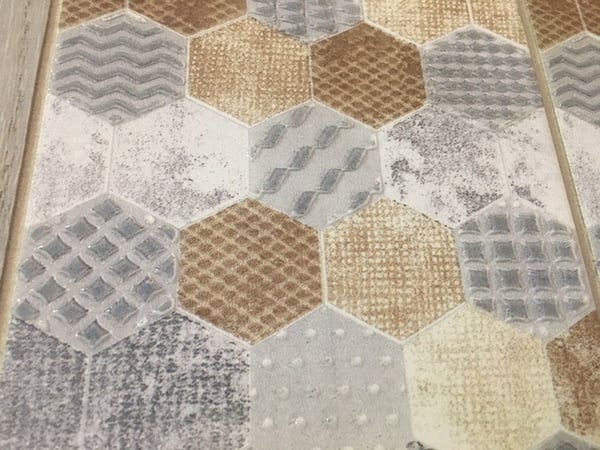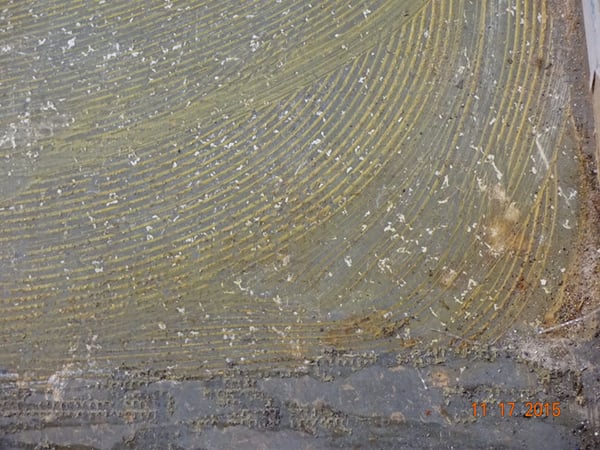
If you've been installing tile for a while, you've certainly encountered situations where you were asked about tiling over an existing tile installation rather than taking up the tile and/or underlayment and starting from fresh. How did you respond?
Here are two situations Mark Heinlein CTI #1112 and National Tile Contractors Association
Training Director to help explore possible responses.
Should You Tile It Over or Take It Up?
1. Tile with Pro Flex Underlayment Beneath It
In this situation, the installer had completed the tile demolition and discovered that Pro Flex underlayment was beneath the tile. He asked if he could simply tile over it rather than remove it.
Furthermore, if he were to take it up, would scraping the tar residue be sufficient?
Mark's Recommendation: Take it up
ANSI A108 is the Installation Standard Specification for Ceramic Tile. Listed in the general requirements for tile installations, A108.02 4.1.1 states:
“All surfaces shall be structurally sound, clean, dry, and free of oily or waxy films and all foreign matter. Concrete surfaces shall be free of form oil, curing compound laitance, and cracks.”
Mark doesn't recommend leaving the former membrane in place unless you, as an installer, are absolutely certain the membrane is sound, properly adhered to, and ready to support a new tile installation.
Can you confidently answer these questions?
- Did the old installation fail?
- If so, what was the cause of failure?
- Was it an installation or structural problem?
- If it was properly installed, is the membrane still well adhered to and able to perform its job to support the new installation?
- Did it survive the demolition process intact?
Avoid Bond Breakers
Residue from a previously installed membrane would be considered foreign matter and could potentially be a bond breaker. The setting material of the new tile installation may not achieve an adequate bond to the old residue, dooming it to failure.
To determine if a bond breaker is present, simply drop some water on the surface and observe how quickly (or not) it absorbs. If it doesn’t absorb within a few minutes, it is likely that many setting materials will not adhere to it.
>> See Substrate Preparation 101: Banish All Tile Installation Bond Breakers
Mechanically Prepare the Substrate If You Can't Find a Bond-enhancing Primer
Many setting materials manufacturers make a bond-enhancing primer that may yield an adequate bond to the questionable substrate. As with any unfamiliar product, always check with your setting materials manufacturer to ask if they have a product or system they recommend.
Otherwise, mechanically abrading the surface will normally prepare the substrate along with removing all foreign matter that may be present.
Be very careful to protect yourself and the surrounding area from any airborne contaminants created by mechanically abrading.

2. Tiling Over Tile at a YMCA
In this situation, the tile installer is working as a subcontractor to the general contractor installing tile over tile at a YMCA:
- Installing new 4x4 wall tile and new 2x2 floor tile over existing 2x2 porcelain mosaic tile in two shower areas and one dry sauna.
- Installing the same tile over the existing continuous-use steam shower
The installer has been able to confirm the following details:
- The existing tile 2x2 porcelain mosaic on floor walls and ceiling appears to be adhered well
- The substrate is concrete block
- The ceiling isn't pitched, and the contractor proposes to pitch a new ceiling under the existing ceiling
- One floor drain; the contractor proposes to remove the existing one and add 2 new drains
- Two existing natural stone benches; the contractor proposes to remove those and build 2 new benches
- There are visible cracks in the 2x2 tiles where they meet the ceiling, both inside and outside of the steam shower.
Here are the unknowns:
- How and if the steam room has been waterproofed.
- If there is any insulation within the existing block wall or existing ceiling (most likely not).
- The cracking that is taking place on the outside of the steam shower on the upper portion of the wall, how has the steam shower contributed to that?
- How well are the existing tiles adhered to? Several tiles on the upper portion show signs of failure.
- If there is an existing membrane in place, will that cause issues with a second membrane being applied over the top?
Given what's known and the many unknowns, is there a way to achieve this installation by waterproofing and tiling over the existing tile, new ceiling, and new benches?

Mark's Recommendation: Don't tile over the tile
Based on the information provided, Mark does not recommend a tile-over-tile installation for the existing continuous-use steam shower.
TCNA Handbook method SR613-18 refers to the details and best practices for a continuous use steam shower installation.
>> See TCNA FAQ on Steam Rooms
Major Consideration: the steam room's existing vapor barrier
Not knowing whether the existing steam room has a properly specified, properly installed, and intact vapor barrier is a major consideration. If there is an existing low perm membrane, it is impossible to know its condition and whether it (and its installation) can be trusted to protect the integrity of the system and the surrounding structure.
Complete Removal of the Existing System: The only way to verify
Cracked tiles in the existing installation may point to problems somewhere within the system that are nearly impossible to see or detect. However, something caused the tile to crack which must be determined before moving forward.
This can only be verified by complete removal of the existing system. Every part of the installation must be intact and correctly installed with proper materials to function correctly and protect the surrounding structure.
Confirm Drain Number and Placement
It may be wise to include additional floor drains based on the amount of use and water expected to be handled by the drain, waste, and vent system.
Consider employing a mechanical contractor or mechanical engineer to make the determination of the number of drains and their placement.
Be Sure to Slope to the Drain
The contractor proposed modifying the ceiling to meet the 2” pitch requirement. Benches and horizontal surfaces must all have a 1/4” vertical per 12” horizontal slope to drain.
>> See Does Your Tile Slope to the Drain?
Other Details to Address
Insulation, air gaps, slip joints, and slope to drain are all critical elements that must be addressed and properly installed by the appropriate contractor.
Problems with Applying a Second Membrane
Let's talk about membranes.
Applying a second membrane is problematic in that it may trap moisture between it and an existing membrane (if any). If there is no existing membrane, it is not possible to know the structural soundness of the existing installation (and its future performance) unless it is inspected during the tear-out process.
Removing tile to inspect the existing conditions will likely damage any existing membrane requiring it to be replaced.
Can You Obtain a System Warranty?
Finally, can you obtain a manufacturer's warranty?
Unless you are able to obtain a written system warranty from a vapor barrier/membrane/setting material manufacturer, you will likely carry a large amount of risk for the future performance of a tile-over-tile installation in this continuous-use steam shower.
In Mark's opinion, this project is an excellent candidate for full demolition and a carefully specified reconstruction.
How Have You Determined Whether to Tile It Over or Take It Up and Start Over?
What similar situations have you encountered and how did you respond?
Let us know in the comments below.
Thanks for reading!
Note: We originally published this article on 05/01/2019, and have updated it.

